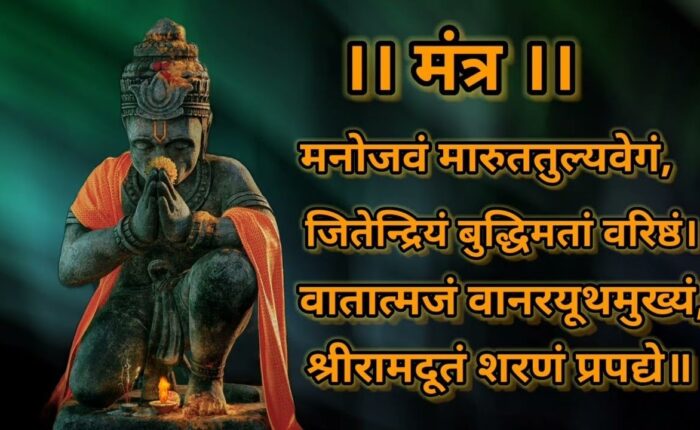A Short Prayer for Hanumanji

Hanuman Chalisa and Bajrang Baan composed by Goswami Tulsidas in the Avadhi language are the two most common prayers for Hanuman Upasana (invocation). The total time for a full recitation of both should be about 5 minutes for each. There are records for full recitation of Hanuman Chalisa in 90 seconds but such fast-paced prayer should be avoided.
One prevalent prayer for Hanuman is found in “Sri Ram Raksha Stotram” composed by Budhkaushik Muni in Sanskrit which occurs in Anand Ramayan. It is a group of 38 shlokas for Ram Upasana and for seeking all-around protection (armour) for the constituent parts of the body and the surroundings in which the devotee resides. Shloka 33 of Ram Raksha Stotram is for the inseparable devotee of Ram represented by Hanuman. For those who lack time for prayers, this shloka can be convenient and can be recited in less than 20 seconds. The shloka is as follows.
मनोजवं मारुततुल्यवेगं
जितेन्द्रियं बुद्धिमतां वरिष्ठम ।
वातात्मजं वानरयूथमुख्यं
श्रीरामदूतं शरणं प्रपद्ये ।
“Manojavam Marut-Tulya Vegam
Jitendriyam Buddhimatam Varistham
Vatatmajam Vanaryuth Mukhyam
Sri Ram Dutam Sharanam Prapadye”
Short interpretations of the words selected for the prayer of Hanuman have been given below.
- Manojavam: “Man” or “Chitta” (mind) is the fastest-moving entity acknowledged by all. Hanuman is a similarly conceptualised entity whose decisions for completing the work of Ram are immediate and instant.
- Marut-Tulya-Vegam: The speedy movement of Hanuman from one place to another is comparable to the speed of wind. He is endowed with the capability of fast movement with the physical body.
- Jitendriam: Hanuman has complete control over his sense organs and is free from personal lust. He is a bal-brahmachari which enhances his performance capabilities.
- Buddhimatam Varishtham: Hanuman has been characterized by Valmiki as the embodiment of wisdom, intelligence and quick-wittedness. He learnt his lessons from Suryadeva. During the first meeting between Ram and Hanuman in Kishkindha, this was openly admitted by Ram himself. His intelligence gets tasted several times during the search for Sita.
- Vatatmajam: In simple terms, this indicates that Hanuman is Vayu-Putra. Its deeper connotation is that the passage of Hanuman from one place to another is completely unrestricted similar to the passage of wind.
- Vanaryuth Mukhyam: Hanumanji is the leader of Vanars. Vanars are known for their “Markat Mati” (monkey mind) which never remains steady. Restlessness, fickleness, instability and mercurial behaviour of monkeys are well-known. They can be controlled only by those who fully understand the characteristics of monkeys. Hanuman is a similar type of leader.
- Sri Ram Dutam: Hanuman is shown as the messenger of Ram when he met Ravan in Lanka after being imprisoned by Meghanad. His deliverance of message to Ravan was superb. Moreover, he survived only by completing the work allotted to him by Ram, for example, his handing over Ram’s ring to Sita.
- Sharanam Prapadye: The devotee self-submits at the feet of Hanuman for his compassions and blessings. The reciter thus, completes the prayer.
I am a Vedic astrologer by profession. I have done Jyotish Acharya from Bhartiya Vidya Bhawan. I am devoted to my Sadguru Shri Sai Nath of Shirdi. I am also interested in spirituality. I love to guide people.